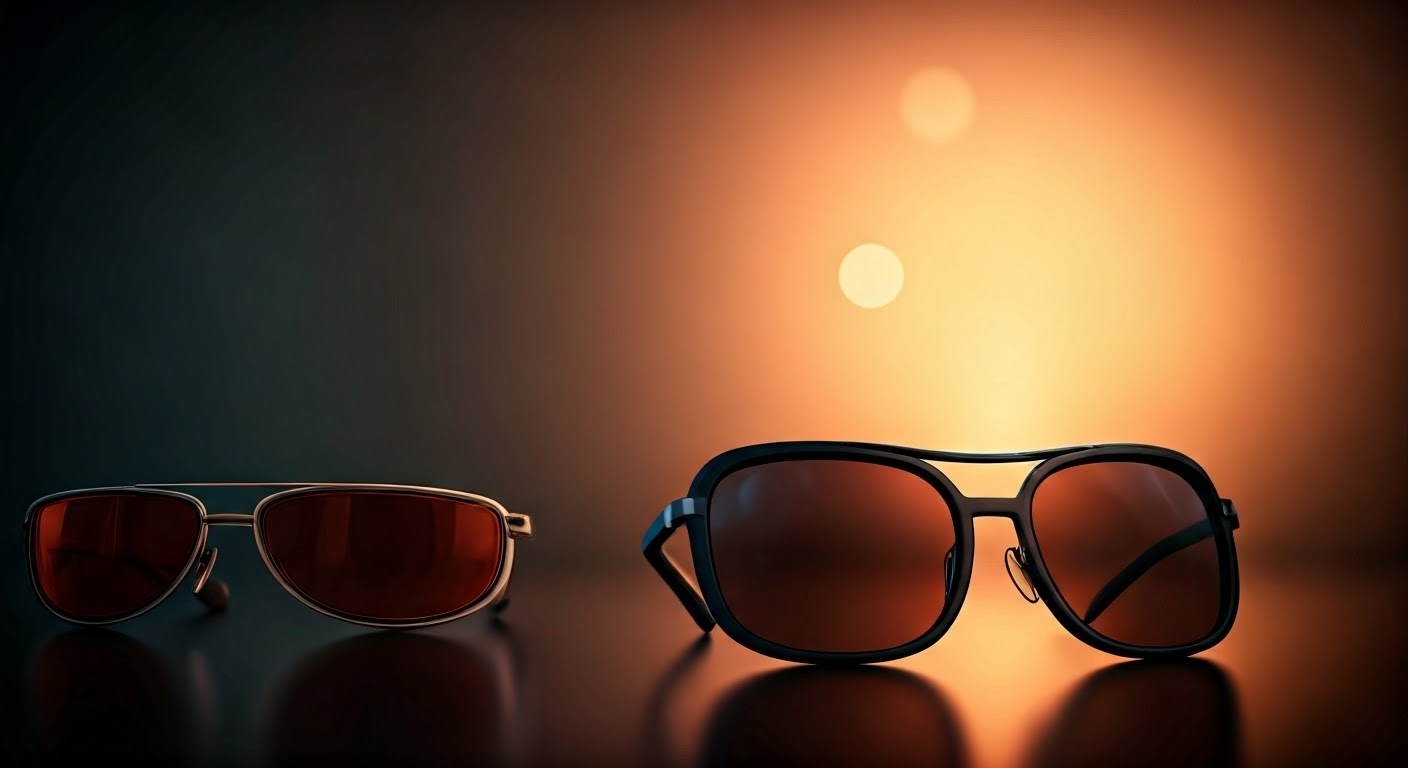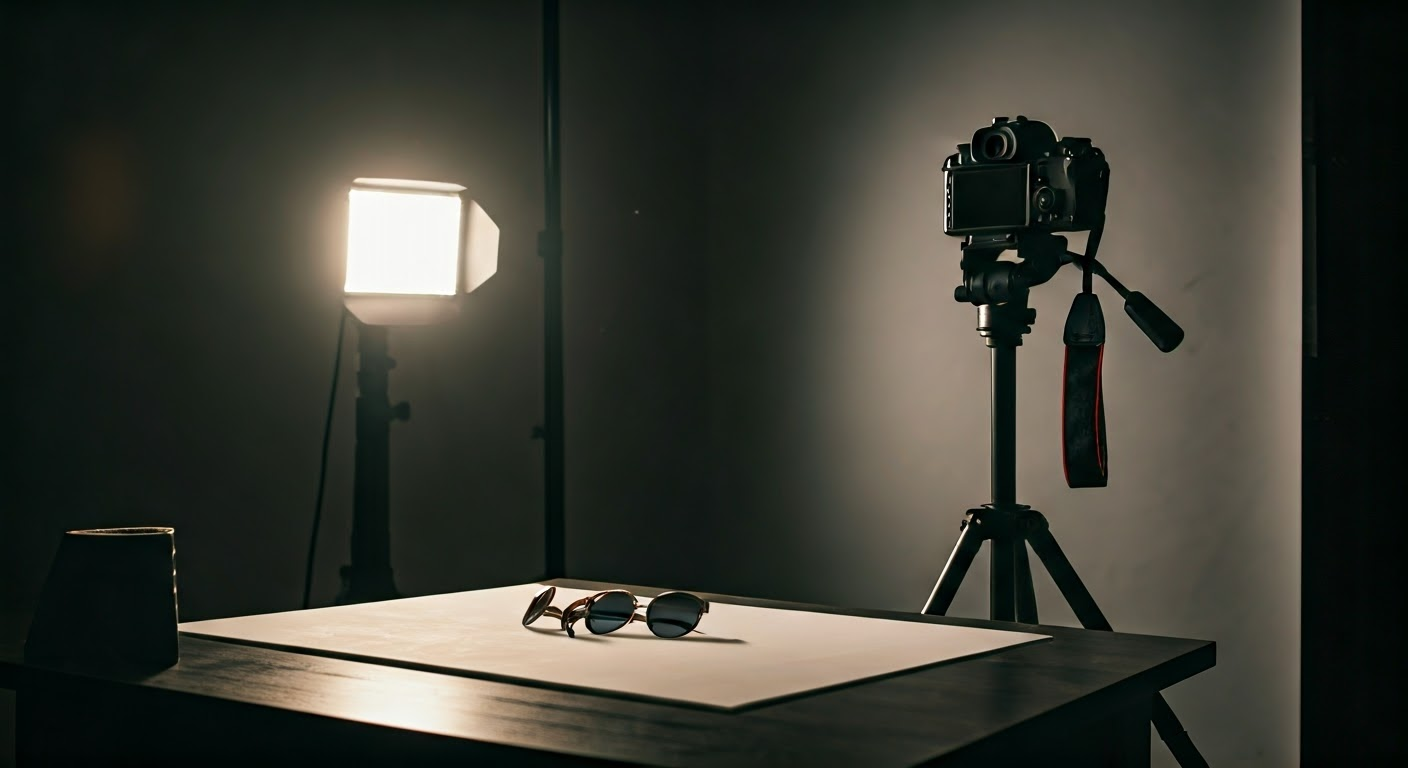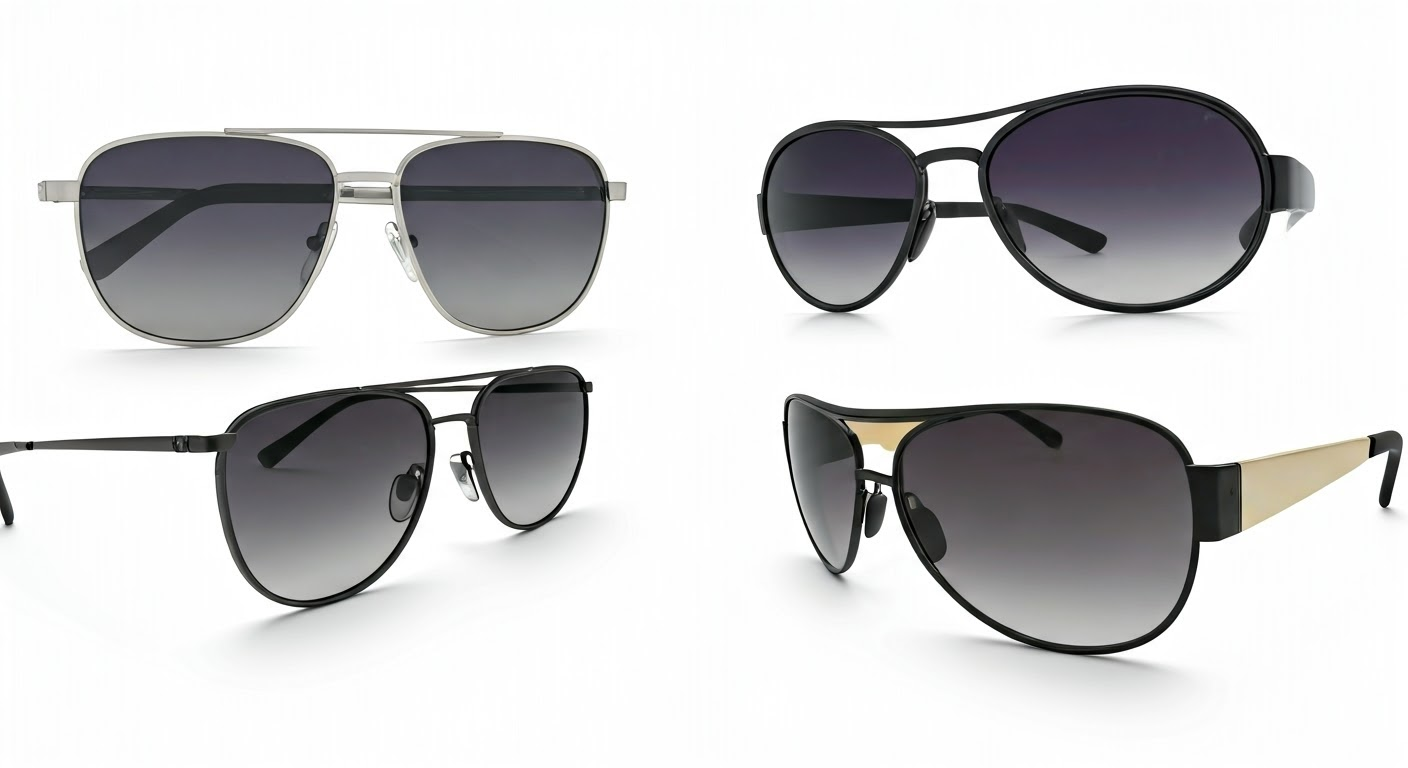
Sunglasses are not just functional accessories; they are fashion statements, making their visual appeal essential for successful e-commerce sales. High-quality product photography helps convey sunglasses’ style, quality, and details to potential buyers, influencing their purchasing decisions. Capturing professional-looking photos requires a mix of technical expertise and the right equipment creativity, ensuring that the images are clear, attractive, and accurately represent the product.
This blog will explore the essential steps, tools, and techniques needed to photograph sunglasses effectively for e-commerce platforms, helping you create visuals that stand out in a competitive market.
Enhanced with the power of technology, we will also delve into innovations like 360-degree spin imagery, product videos, and 3D models, which can significantly enhance the quality of your sunglasses photography, thus bolstering your online presence. Let’s join us to harness these insights and techniques to put your best lens forward.
Why Is Sunglasses Product Photography for E-Commerce Important?

With the booming growth of ecommerce, the significance of sunglasses product photography has increased manifold. The high dependency of customers on visuals for an online purchase decision turns ecommerce product photography into a powerful tool for conversion. High-quality images displaying the intricate details of sunglasses can engage customers, improve credibility, and strengthen your brand’s image.
Also, sunglasses, being a product with reflective surfaces and minute detailing, demand immaculate photography to combat unwanted glare and reflections and adequately capture their style and make.
How To Do Sunglasses Product Photography for E-Commerce?

Mastering sunglasses photography requires balancing technical aspects and artistic flair. Using the correct camera settings and experimenting with the best angles, the primary steps offer interactive viewing experiences to your online consumers. Let’s consider the nine essential factors required to photograph a pair of glasses for your online stores.
1. Preparation and Setup
Top-notch product photography glasses begin with adequate preparation and setup.
Here are some crucial steps to follow:
- Categorize sunglasses: Set an organized workflow by sorting your sunglasses by design, model, frame type, or lens type. This aids in quicker selection during the photoshoot.
- Maintain a clean workspace: Ensure your eyewear and props are clean to prevent dust particles or fingerprints from appearing in photographs.
- Use the right props: Deploy white cloth or other neutral-colored backgrounds for best results. The props should neither overshadow your sunglasses nor produce unwanted reflections.
- Setup equipment: Invest in a quality photo studio for optimum lighting control. Devices like motorized turntables can vastly aid the process, ensuring smooth rotation and consistent shots.
2. Lights and Camera Settings
Lighting is the cornerstone of any photography, and it takes centerstage when shooting products like sunglasses, which are notorious for their reflective surfaces.
Here’s what you need to do:
- Optimize Camera Settings: Adjust aperture, shutter speed, and ISO to control light interaction with sunglasses. Experiment with lighting angles for proper exposure and desired effects.
- Use Professional Lighting Software: Leverage studio software to automate and save lighting setups, enhancing efficiency for photographing similar products.
- Handle Reflective Surfaces Carefully: Use white cards to soften the light and black cards for negative fill, minimizing harsh reflections on mirrored lenses.
- Maximize Light Control: Incorporate multiple light reflectors to ensure even illumination while highlighting intricate details and maintaining balance in reflections.
3. Automation and capture control
Automation plays a decisive role in modern product photography. A control software allows photographers to have complete control over image capture, lighting settings, and processing functionality.
Here’s a glimpse of some capabilities:
|
Feature |
Usage |
|
Presets |
Store photoshoot configurations to automated settings. |
|
Robotic Arm |
Provides precision in capture as well as movement of the mounted camera. |
|
Laser-guided positioning |
Ensures accurate object placements. |
|
Auto calibration |
Helps maintain optimum light settings. |
4. Angles to Show on Shopping Product Pages
The angles you choose to portray your sunglasses can significantly influence your customer’s perception of the product.
Here are some methods to consider:
- Front View (Hero Image): It serves as the first impression of your product. Make sure it’s appealing and shows your sunglasses in its entirety.
- Side View: This angle helps in showing the side design and thickness of the sunglasses frame.
- 3/4 View: A vital perspective showcasing both the front and profile of the sunglasses, adding extra dimension to product representation.
- Elevations and Rotations for 360-Degree Views: Adjust the angle of elevation slightly and use a synchronized turntable to capture comprehensive 360-degree spins, showcasing all facets of reflective sunglasses with clarity and precision.
5. Capturing fine details and showcasing design
Capturing the fine details of sunglasses positively impacts customers’ perceived product value. Distinct components such as glasses, arms, hinges, or branding logos need careful attention. The main concern is that reflections and transparencies can sometimes make these details challenging to capture. Therefore, sunglasses should be grouped with similar photographic elements.
Here’s what you need to learn:
- Neutral Backgrounds Matter: Use a neutral environment to eliminate distractions and prevent reflections from being misinterpreted as flaws or unwanted design elements.
- Importance of Focus Stacking: Combine multiple images taken at varying focus levels to create a sharp and detailed final photograph, ensuring all areas of the sunglasses are clear and precise.
- Technology Integration: Leverage tools for automated focus stacking, streamlining the process and enhancing image quality.
- Enhanced Product Display: Focus stacking ensures that every part of the eyewear, from frames to lenses, appears in sharp focus, providing potential buyers with a realistic and accurate view.
6. Taking Pictures of Special Cases
Certain circumstances demand specialized approaches. For instance, highly reflective sunglasses can be challenging. A photographic tent or diffusion backdrop can help control reflections in such cases.
Some ways to take pictures of exceptional cases include:
- Polarized or Mirror Lenses: Use light reflectors alongside black and white cards to balance lighting, reducing unwanted reflections or excessive shine.
- Transparent Frames: Adjust light intensity carefully to highlight the frame’s details without overexposure or distracting glare.
- Post-Production Tweaks: Brightness and light adjustments during editing can significantly enhance the visibility and appeal of transparent or complex frames.
- Experimentation is Key: Test various lighting setups and angles to achieve a polished and professional look for both reflective and transparent sunglasses.
7. The Visual Identity of Your Online Store
Maintaining consistency helps reinforce your brand’s identity in your online store. It’s instrumental in creating a strong visual impact on your consumer’s mind.
Here’s how you can ensure it:
- Viewing Angles: Keep them consistent across all products. This presents a uniform and professional look to your online store.
- Photographic Elements: Group merchandise having similar elements together. This reduces the wastage of time switching settings between shots.
- Style Guide: Establish one to specify how to photograph and edit product images. This ensures consistency across all the website’s product image outputs.
- Brand Color: Try to include your brand color subtly in your photos. This unconsciously builds brand recall in the customer’s mind.
8. Enhancing Product Photography with 360 Spins, Videos, and 3D Models
The role of augmented reality in enhancing e-commerce experiences is becoming increasingly relevant. Features such as 360-degree spin photographs and interactive zoom allow customers a detailed inspection of the product virtually. It’s close to holding the product in their hands, ensuring they know exactly what they are buying.
Adding interactive features like photogrammetry 3D models and product configurators, consumers can customize products on the go and even view your catalog in augmented reality.
Below is a tabulation of some of these techniques:
|
Enhanced Photography Type |
Usage |
|
360-degree spins |
Allows customers to view products from all angles. |
|
Videos |
Showcases the product in motion, adding a real-life effect. |
|
3D Models |
Offers a 3-dimensional view, especially catering to intricate designs. |
|
Product Configurators |
Allows real-time customizations encouraging buying decisions. |
9. Smooth, easy and productive photoshoots
Achieving smooth, easy, and productive photoshoots for sunglasses involves meticulous planning and execution.
Here’s what you need to include:
- Proper Equipment: Use essential tools like light reflectors and clean background props to ensure a professional look.
- Consistent Setup: Position sunglasses precisely on the centerless table to maintain uniform shots.
- Effective Lighting: Minimize glare and reflections by adjusting light angles and using diffusers or black/white cards.
- Comprehensive Angles: Experiment with different angles to effectively showcase every detail of the sunglasses.
Transform Your Sunglasses Photography with Flix Studio
At Flix Studio, we specialize in capturing the essence of sunglasses through exceptional product photography. With advanced equipment and a dedicated approach, we ensure your eyewear images reflect premium quality and style, helping your brand stand out.
Leveraging our 60-point High-Quality Image Assurance (HQI) system, we deliver flawless results that highlight every detail of your sunglasses. Partner with Flix Studio for industry-leading expertise and a photography experience that elevates your eyewear brand to new heights.
Talk to an expert today and see the difference!
Conclusion
With the proper understanding and manipulation of the camera, lights, poses, and editing – you can master the art of eyewear product photography. Amidst the rapidly growing e-commerce, compelling visuals are no longer a bonus – they have become a necessity. This guide has provided invaluable insights into this complex but rewarding process.
Be it handling reflective surfaces, working around different types of glass and frame, exploring angles, or using props – every detail, minor or significant, matters. As important as it is to take care of these pictures, post-production care is equally significant in maintaining your brand’s identity and image by maintaining visual consistency across photographs.
Your potential customers will appreciate this effort manifested as top-notch, detailed, and realistic product photography – compelling them to hit ‘buy now.’
Frequently Asked Questions
What are some common mistakes to avoid during sunglasses product photography?
Common mistakes include overlooking unwanted reflections, not paying heed to maintaining a neutral white background, not experimenting with props for flat lay and different lighting effects, and ignoring consistent angles for all photographs, which can hamper the brand’s visual identity in the online store.
How can I remove unwanted reflections from my sunglasses images?
Use props like black and white cards to manage reflections. White cards can reflect soft lights into the glasses, while black ones provide a negative fill to control strong reflections. Additionally, the position of the cards is crucial; using professional photo studios equipped with diffusion backdrops can aid in tackling reflections.
Which lenses work best for product photography?
Macro lenses are often the best option for product photography as they can capture extreme close-ups with sharp detail. However, the choice of lens also depends on the product size and the intricacy of details. Always prioritize clarity and fine detailing in your lens choice.
What can I do to improve the overall quality of my sunglasses product images?
Opt for a well-lit, neutral setup, use macro lenses, experiment with different angles, and always tick off unwanted reflections. Invest in advanced technologies like focus stacking to maintain sharpness. More importantly, keep a consistent visual style throughout your images to strengthen your brand’s identity.



